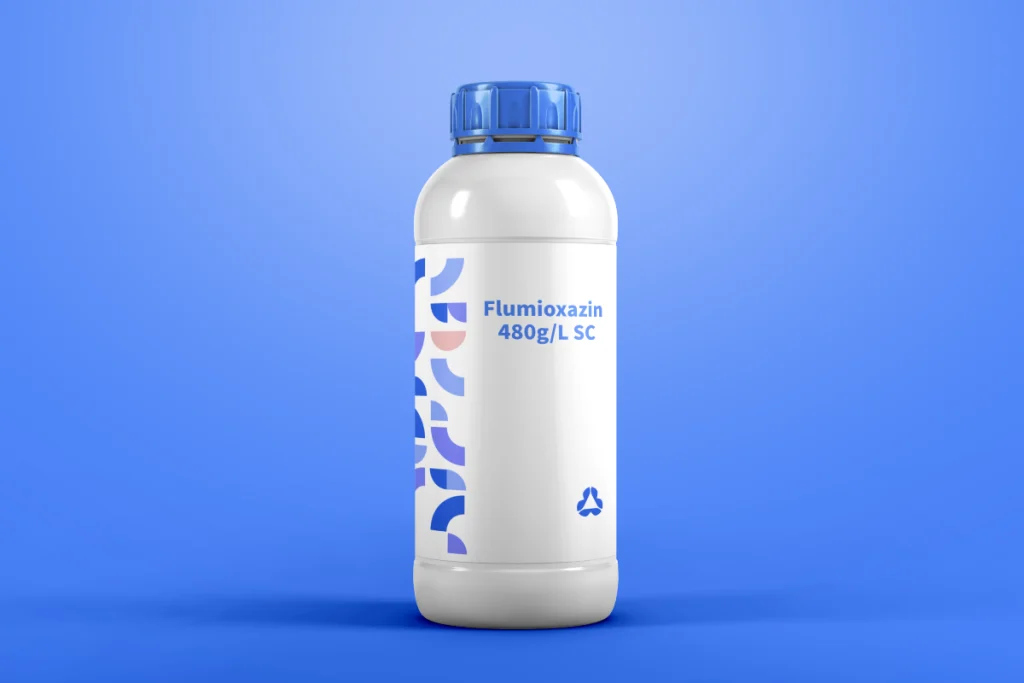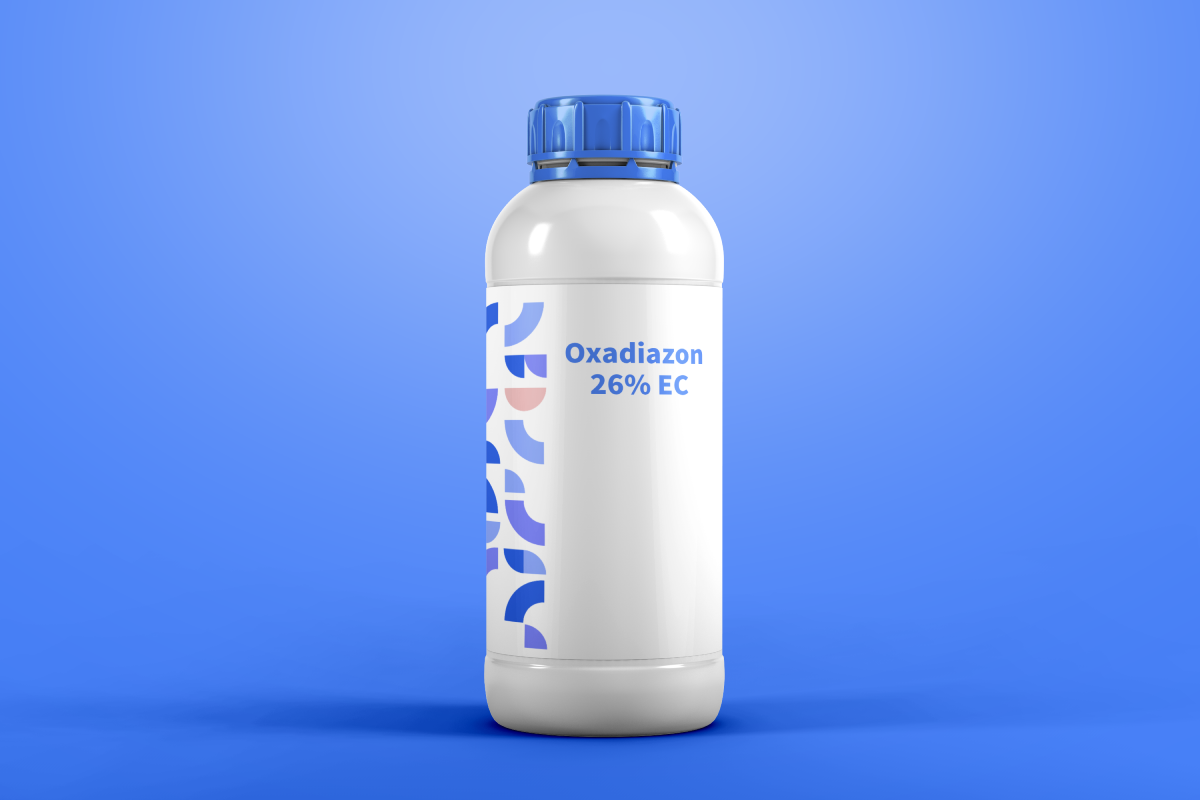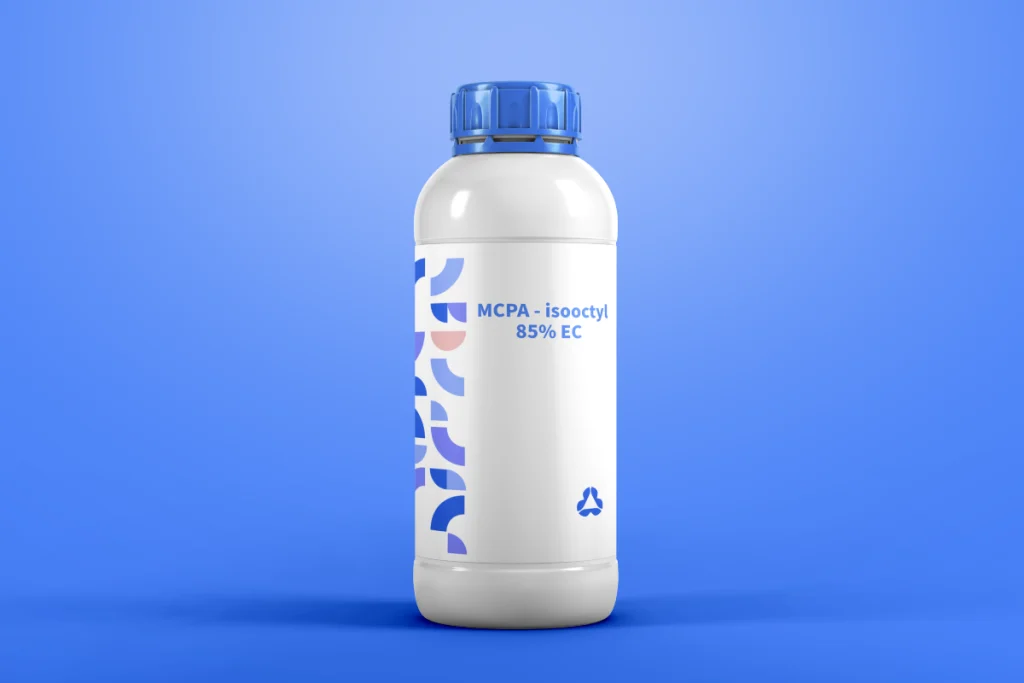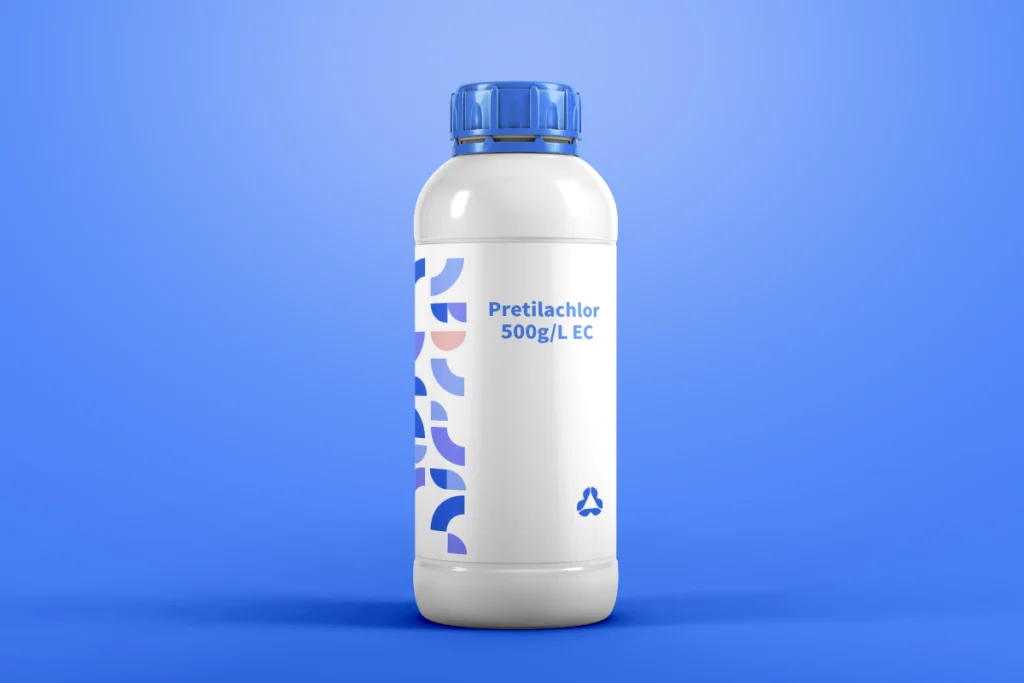| Parameter |
Details |
| Active Ingredient |
Oxadiazon (CAS No. 19666-30-9) |
| Chemical Class |
Oxadiazole |
| Mode of Action |
PPO inhibitor (HRAC Group 14) |
| Formulation Type |
26% EC (260 g/L active ingredient) |
| Appearance |
Yellowish-brown liquid |
| Solubility |
0.07 mg/L in water (20°C) |
| pH Range |
5.0–8.0 |
| Density |
1.05–1.15 g/cm³ |
- Soil Absorption:
- Taken up by germinating seedlings through roots and shoots.
- Biochemical Disruption:
- Inhibits PPO enzyme, causing accumulation of toxic intermediates that destroy cell membranes.
- Symptom Progression:
- 1–3 days: Rapid wilting and bleaching of emerging seedlings
- 5–7 days: Complete desiccation and death
| Crop |
Target Weeds |
Dosage (L/ha) |
Application Timing |
| Rice |
Barnyardgrass, Monochoria, sedges |
1.5–2.5 |
Pre-emergence (0–5 days after sowing) |
| Vegetables |
Pigweed, lambsquarters, crabgrass |
1.0–2.0 |
Pre-plant incorporation or pre-emergent |
| Turfgrass |
Annual bluegrass, chickweed |
1.0–1.5 |
Pre-emergence in established turf |
| Orchards |
Foxtail, groundsel |
2.0–3.0 |
Pre-emergence, directed spray to soil |
- Water Volume: 300–500 L/ha for soil incorporation
- Adjuvants: Not required for pre-emergent applications
- Tank Mixes:
- Soil Conditions: Apply to moist, well-prepared soil; incorporate mechanically or with irrigation (5–10 mm)
- Broad-Spectrum Control:
- Effective against 30+ annual weeds, including many herbicide-resistant biotypes.
- Long Residual Activity:
- Provides 4–6 weeks of soil protection, reducing weed pressure during crop establishment.
- Crop Safety:
- Selective in rice, vegetables (e.g., tomatoes, peppers), and turf when applied pre-emergent.
- Low Volatility:
- Minimizes risk of drift damage to neighboring crops.
- Environmental Profile:
- Low mammalian toxicity (LD₅₀ > 5000 mg/kg)
- Soil-bound with minimal leaching potential (DT₅₀ 30–60 days)
- Toxicity:
- Moderate toxicity to fish (LC₅₀ 1–10 mg/L); avoid water bodies.
- Toxic to aquatic invertebrates; maintain 100 m buffer from waterways.
- Storage:
- Store at 5–35°C; protect from freezing.
- Handling:
- Wear protective clothing; avoid contact with skin and eyes.
- Standard Packs: 1L, 5L, 20L COEX containers
- Custom Solutions:
- Private labeling with multilingual instructions
- Regulatory support for global markets (EPA, EU, APAC)
- Shelf Life: 3 years under recommended storage conditions
Q1: Can Oxadiazon 26% EC be used post-emergence?
A: No, it is strictly a pre-emergent herbicide. Post-emergent applications will not control established weeds.
Q2: What is the pre-harvest interval (PHI)?
A: PHI varies by crop:
- Rice: 60 days
- Vegetables: 30–45 days (check label for specific crops)
- Turfgrass: No restrictions (non-food crop)
Q3: How to handle resistance management?
A: Rotate with Group 15 (e.g., S-metolachlor) or Group 3 (e.g., trifluralin) herbicides.
Q4: Can it be used in flooded rice fields?
A: Yes, but ensure uniform distribution in shallow water (3–5 cm) and maintain flood for 5–7 days.
Q5: Does Oxadiazon require soil incorporation?
A: Yes, for optimal efficacy, incorporate into the top 2–3 cm of soil via irrigation or mechanical means.
- Rice Trials in Vietnam:
2.0 L/ha controlled 95% of barnyardgrass and 88% of Monochoria for 45 days.
- Vegetable Trials in California:
1.5 L/ha + pendimethalin reduced weed density by 92% in tomato fields.
Oxadiazon 26% EC is a pre-emergent herbicide designed to control annual broadleaf weeds, grasses, and sedges in rice, vegetables, turfgrass, and orchards. It prevents weed germination and early growth by disrupting cell membrane formation in seedlings.
As a PPO (protoporphyrinogen oxidase) inhibitor, it blocks an enzyme critical for chlorophyll and cell membrane synthesis. Germinating weeds absorb it through roots/shoots, leading to rapid wilting, bleaching, and death within 1–3 days.
- Rice: 1.5–2.5 L/ha (pre-emergent, 0–5 days after sowing)
- Vegetables: 1.0–2.0 L/ha (pre-plant or pre-emergent)
- Turfgrass: 1.0–1.5 L/ha (pre-emergent in established turf)
- Orchards: 2.0–3.0 L/ha (directed soil spray)
Yes, apply to shallow-flooded soil (3–5 cm water) and maintain flooding for 5–7 days. This enhances soil adsorption and weed control.
When applied pre-emergent as directed, it is selective for rice, vegetables (e.g., tomatoes, peppers), and turf. Avoid post-emergent use, as it may damage crop seedlings.
- Grasses: Barnyardgrass, crabgrass, foxtail
- Broadleaf weeds: Pigweed, lambsquarters, chickweed
- Sedges: Yellow nutsedge, flatsedge
It provides 4–6 weeks of residual control. Soil half-life is 30–60 days, depending on moisture and temperature.
Yes, compatible with pendimethalin (broadleaf control) or quinclorac (grasses). Always jar-test mixtures for stability before full application.
- Rice: 60 days
- Vegetables: 30–45 days (check labels for specifics)
- Turf/orchards: No PHI restrictions (non-food uses)
Yes, incorporate into the top 2–3 cm of soil via irrigation (5–10 mm) or mechanical tillage to prevent photodegradation and ensure seedling contact.
Moderately toxic to fish and invertebrates (LC₅₀ 1–10 mg/L). Maintain a 100 m buffer from water bodies and avoid application before heavy rain.
No, it only controls weeds at the germination stage. Post-emergent weeds require other herbicides (e.g.,
glyphosate for non-selective control).
Store at 5–35°C in a sealed container, away from sunlight, heat, and food/feed. Shelf life is 3 years under proper conditions.
Wear chemical-resistant gloves, goggles, long sleeves, and pants. Avoid inhalation or skin contact.
Best in loam/clay soils with 1–3% organic matter. In sandy soils, use lower rates to reduce leaching risk.
No, it targets annual weeds only. Perennials require systemic herbicides (e.g., triclopyr) for effective control.
Registration varies by region. Contact local agricultural authorities or your supplier for compliance support (e.g., EPA, EU Annex 1).
Rotate with herbicides from other groups (e.g., Group 15 for grass control) and avoid consecutive annual applications.
No, Oxadiazon is a synthetic herbicide. Organic alternatives include mulching or flame weeding.
Absorb with inert material, place in sealed containers, and dispose per local hazardous waste regulations. Rinse affected areas with water.
Contact us for regional application guides or custom formulation support.




